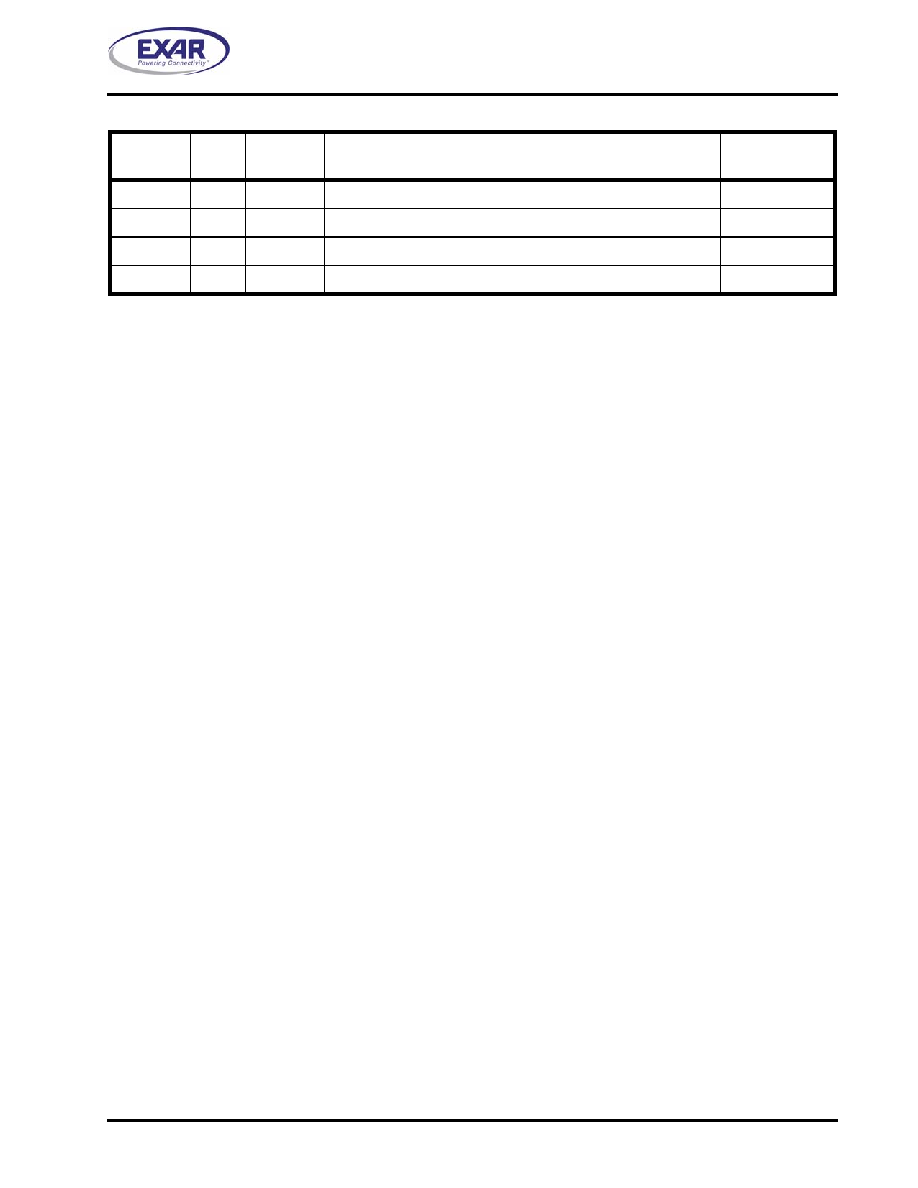- 您現(xiàn)在的位置:買賣IC網(wǎng) > PDF目錄16428 > XR17V254IV-0A-EVB (Exar Corporation)EVAL BOARD FOR XR17V254 144LQFP PDF資料下載
參數(shù)資料
| 型號(hào): | XR17V254IV-0A-EVB |
| 廠商: | Exar Corporation |
| 文件頁數(shù): | 3/70頁 |
| 文件大小: | 0K |
| 描述: | EVAL BOARD FOR XR17V254 144LQFP |
| 標(biāo)準(zhǔn)包裝: | 1 |
| 系列: | * |
第1頁第2頁當(dāng)前第3頁第4頁第5頁第6頁第7頁第8頁第9頁第10頁第11頁第12頁第13頁第14頁第15頁第16頁第17頁第18頁第19頁第20頁第21頁第22頁第23頁第24頁第25頁第26頁第27頁第28頁第29頁第30頁第31頁第32頁第33頁第34頁第35頁第36頁第37頁第38頁第39頁第40頁第41頁第42頁第43頁第44頁第45頁第46頁第47頁第48頁第49頁第50頁第51頁第52頁第53頁第54頁第55頁第56頁第57頁第58頁第59頁第60頁第61頁第62頁第63頁第64頁第65頁第66頁第67頁第68頁第69頁第70頁

XR17V254
11
REV. 1.0.1
66MHZ PCI BUS QUAD UART WITH POWER MANAGEMENT SUPPORT
NOTE: RWR=Read/Write from AD[31:0]. RO= Read Only. RWC=Read/Write-Clear.
1.2.1
Power States and Power State Transitions of the V254
The XR17V254 supports D0, D3hot and D3cold power states and is capable of generating the PME# signal
from the D3hot state. The following paragraphs describe these power states and Figure 4 shows the power
state transitions of the V254.
D0 STATE
The XR17V254 must be placed in the D0 state before being used in a system. The D0 state represents two
states - D0 Uninitalized and D0 Active. Upon entering D0 from power up or transition from D3hot, the V254 will
be in the D0 Uninitialized state. Once initialized by the system software, the V254 will enter the D0 Active state.
In the D0 Active state, the V254 is fully functional and will respond to all PCI bus transactions as well as issue
interrupts (INTA#). The system software can program the V254 to enter the D3hot state from the D0 state.
D3
HOT STATE
The V254 enters the D3hot state when the system software programs the V254 from D0 to D3hot. In this state,
the V254 will not be fully functional. The V254 will respond only to PCI configuration space accesses, if a PCI
clock is provided and will not respond to PCI memory accesses nor will it issue interrupts. However, the V254
will continue to receive data and the automatic software and hardware flow control, if enabled, will continue to
function normally. While in the D3hot state, the V254 asserts the PME# (Power Management Event) signal, if
enabled by setting PME_Enable bit, upon one of the following events:
■ RX pin of any of the channels goes LOW (START bit detected), or
■ Any of the delta bits of modem inputs (MSR register bits [3:0]) is set in any of the 4 channels (see
The V254 also sets the PME_Status bit when such an event occurs, regardless of whether the PME_Enable bit
is set or not. The system software can reset the PME_Status bit by writing a ’1’ to it. When the system software
programs the V254 from D3hot to D0, typically in response to the PME# signal, the V254 enters the D0 Active
state and will retain all the values of its internal registers. The V254 will keep its PCI signal drivers disabled for
the duration of the D3hot to D0 Uninitialized state transition. The V254 saves the PME context (configuration
registers and functional state information) in the D3hot state.
Note: The V254 has a sleep mode which keeps the power consumption to a minimum (see Sleep Mode
description on page 22). This is independent of the power state the V254 is in. The user can optionally place
the V254 in sleep mode (via the software driver) in the Active D0 state anytime or specifically when the system
software commands the V254 to enter the D3hot state. The crystal oscillator shuts down when the conditions
given in Sleep Mode section on page 22 are satisfied, and re-starts when one of the events as described in the
same section occurs. Upon re-starting, the oscillator may take a long time to settle. This time may be more
than 20ms which is the maximum wait time guaranteed by the system software before resuming normal PCI
bus transactions in the Active D0 state. Therefore, there may be data errors if the V254 is commanded to
transmit data before the oscillator is ready. It is recommended not to use sleep mode while in the D3hot
state for this reason.
14:9
RO
Reserved
00000b
8
RWR
PME_Enable
0b
7:2
RO
Reserved
000000b
1:0
RWR
PowerState
00b
TABLE 2: POWER MANAGEMENT REGISTERS
ADDRESS
OFFSET
BITS
TYPE
DESCRIPTION
RESET VALUE
(HEX OR BINARY)
相關(guān)PDF資料 |
PDF描述 |
|---|---|
| RPS0J102MCN1GS | CAP ALUM 1000UF 6.3V 20% SMD |
| EMM10DRMN | CONN EDGECARD 20POS .156 WW |
| GBA31DRMN-S288 | CONN EDGECARD 62POS .125 EXTEND |
| CM100505-18NGL | INDUCTOR CHIP 18NH 1005 SMD |
| 1-6828247-5 | CA,SM,MTRJ-SC |
相關(guān)代理商/技術(shù)參數(shù) |
參數(shù)描述 |
|---|---|
| XR17V254IV-F | 功能描述:UART 接口集成電路 66MHz Quad PCI UART RoHS:否 制造商:Texas Instruments 通道數(shù)量:2 數(shù)據(jù)速率:3 Mbps 電源電壓-最大:3.6 V 電源電壓-最小:2.7 V 電源電流:20 mA 最大工作溫度:+ 85 C 最小工作溫度:- 40 C 封裝 / 箱體:LQFP-48 封裝:Reel |
| XR17V258 | 制造商:EXAR 制造商全稱:EXAR 功能描述:66MHZ PCI BUS OCTAL UART WITH POWER MANAGEMENT SUPPORT |
| XR17V258_08 | 制造商:EXAR 制造商全稱:EXAR 功能描述:66MHZ PCI BUS OCTAL UART WITH POWER MANAGEMENT SUPPORT |
| XR17V258IV | 功能描述:UART 接口集成電路 66MHz Octal PCI UART RoHS:否 制造商:Texas Instruments 通道數(shù)量:2 數(shù)據(jù)速率:3 Mbps 電源電壓-最大:3.6 V 電源電壓-最小:2.7 V 電源電流:20 mA 最大工作溫度:+ 85 C 最小工作溫度:- 40 C 封裝 / 箱體:LQFP-48 封裝:Reel |
| XR17V258IV-0A-EVB | 功能描述:UART 接口集成電路 Supports V258 144 ld TQFP, PCI Interface RoHS:否 制造商:Texas Instruments 通道數(shù)量:2 數(shù)據(jù)速率:3 Mbps 電源電壓-最大:3.6 V 電源電壓-最小:2.7 V 電源電流:20 mA 最大工作溫度:+ 85 C 最小工作溫度:- 40 C 封裝 / 箱體:LQFP-48 封裝:Reel |
發(fā)布緊急采購,3分鐘左右您將得到回復(fù)。